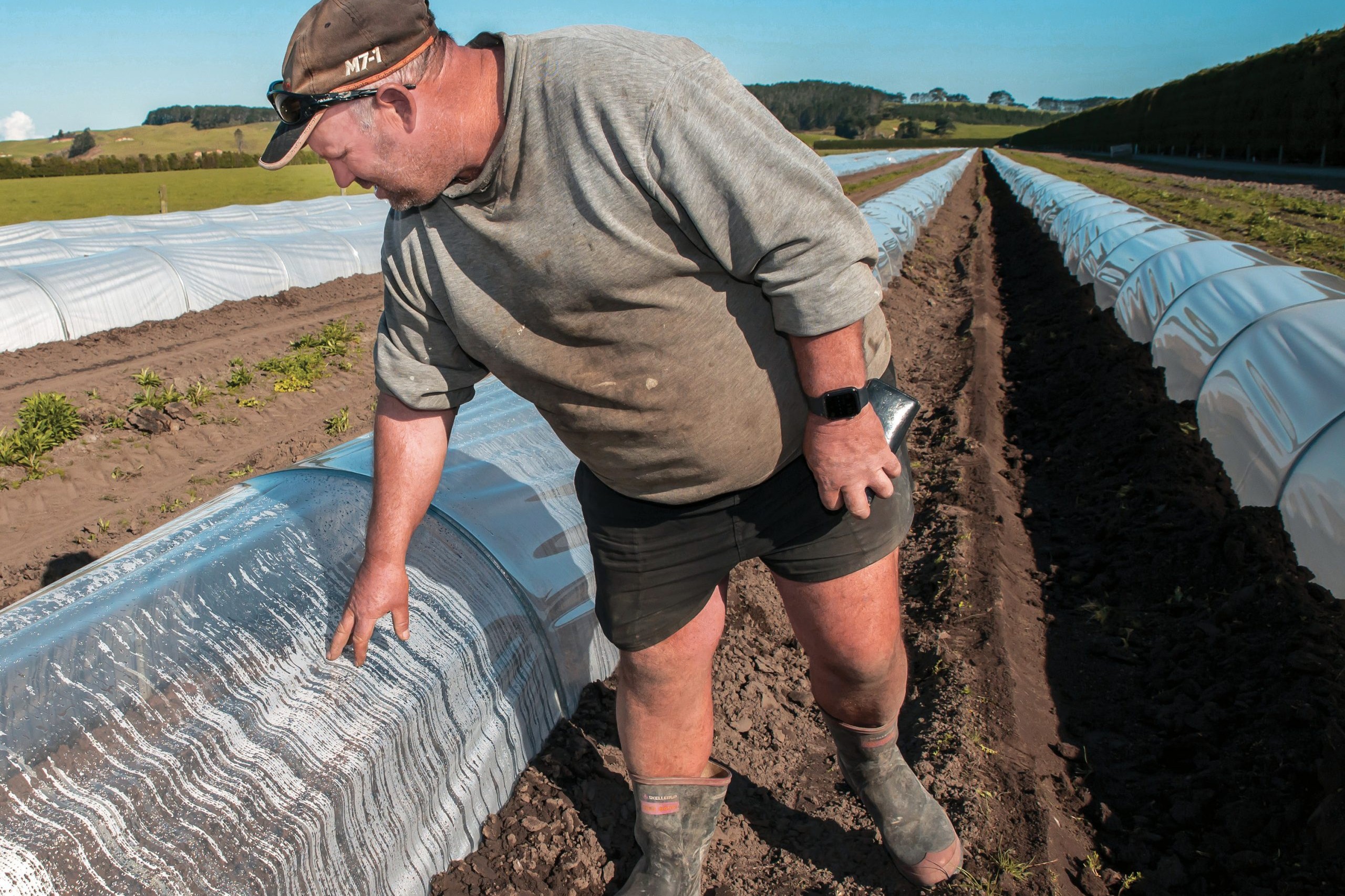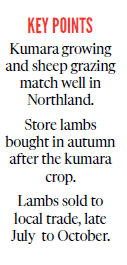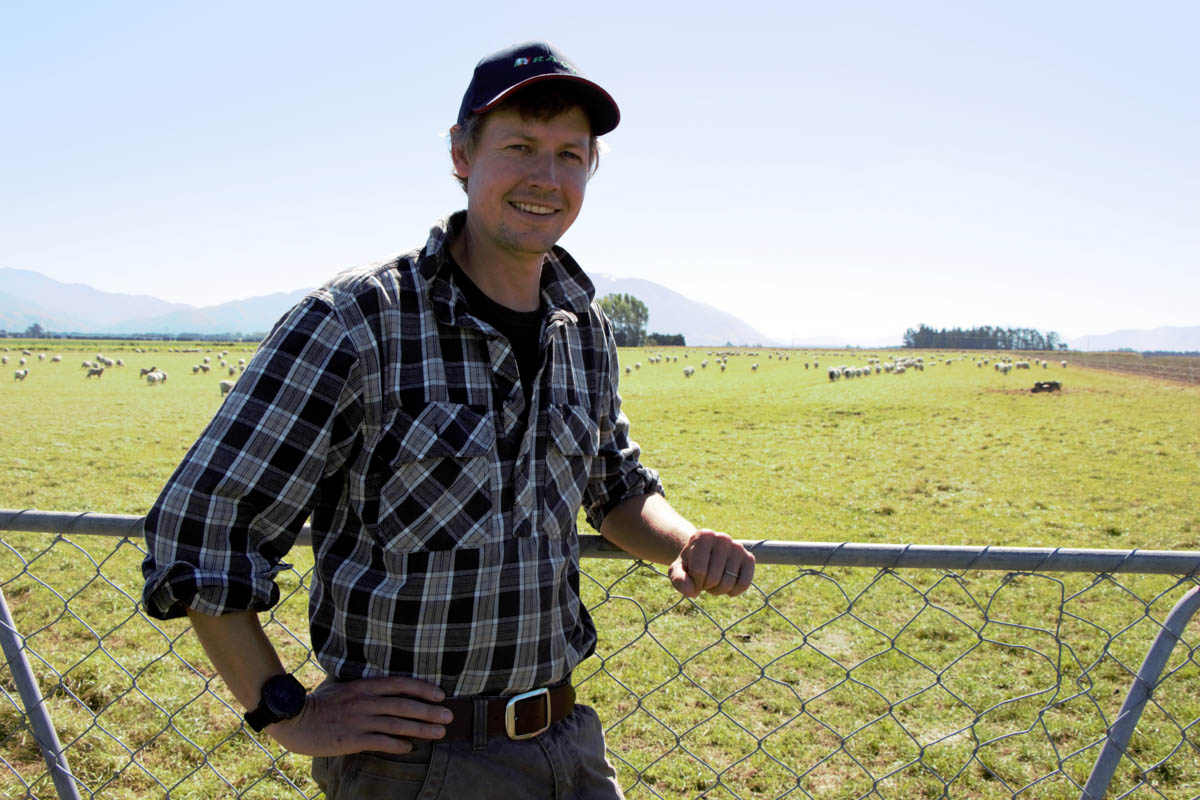Kumara and lamb mix sweet

A combination of growing kumara and grazing lambs makes an excellent fit for a Northland farmer. By Glenys Christian. Photos by Malcolm Pullman.
While sheep numbers may have dropped markedly in Northland over the last 30 years they’re still a very important component of kumara growers’ operations.
The industry, based around the Kaipara Harbour, especially in the Ruawai and Dargaville areas on the west coast, is relatively small, taking up about 1500 hectares. But it’s very important to the local economy despite returns varying considerably from season to season. And after the kumara crop is harvested in autumn and grass sown, lambs are gradually brought in to be finished on the new pasture.
Doug Nilsson is chairman of the Northern Wairoa Vegetable Growers’ Association and this winter has about 2000 head on his 200 ha farm inland from Baylys Beach, just northwest of Dargaville.
He was brought up on his parents’ sheep and beef farm further north before they diversified into leasing land to grow buttercup squash.
“But in the 1980s things got tough for sheep and beef farming, with Rogernomics kicking in and subsidies going,” he says.

The family eventually sold their sheep and beef blocks from 1988 through to 1991 and bought two adjoining dairy farms further south which weren’t economic, putting in sub-surface drainage to improve the land for cropping. They continued to lease land, growing about 60ha of squash and starting to grow a little bit of kumara.
Doug and his wife, Ann, took over the farm in 2002 phasing out squash and concentrating on kumara. They bought a further five small adjoining properties, amalgamating them and growing only kumara and sometimes some maize for grain. No land is leased now and on their sedimentary clay flats which sit at sea level they slowly changed over to growing kumara on up to 100ha. Doug trialled up to nine different varieties, but now grows just the four main commercial varieties – red, gold, orange and purple.
“With my background with sheep and beef and shearing, bringing lambs into graze through the winter was a neat fit,” he says.
“With the price of store lambs now it’s a big capital outlay to stock up with lambs but still profitable for us and good for sheep farmers as well.”
Many kumara growers follow the same regime but a few will graze lambs for a percentage of weight gain rather than buying them in and having that large expense.
The kumara industry has struggled over recent years with returns far below the cost of production and costs such as labour, fertiliser and fuel going “through the roof”.
Returns are only 50% of what they were in 2002, Doug says, as sales have dropped off and more recently consumers have cut back on kumara purchases as inflation bites.
He’s used workers from Vanuatu under the Recognised Seasonal Employer (RSE) scheme for some years, building onfarm accommodation for them to stay in and often providing an evening meal. But with Covid19 their numbers decreased along with backpacker labour which he also relied on.
This season he hopes to employ 13 RSE workers once more to help fill the shortfall of locals who are not around in the numbers needed. They’ll work onfarm for up to seven months, first planting the crop, then weeding and harvesting it after which an annual grass crop will be sown by Doug or else perennials as part of a rotation of his kumara-growing land.
Sometimes a cover crop of oats or mustard will be planted but not this year. While mustard is valued for its fumigant properties it needs to be incorporated quickly into the soil in order for it to be effective.
Sheep will be bought in when the grass is ready to be grazed, usually about the end of May.
“We need the sheep numbers because they’re doing a job for us,” he says.
“They’re nice and light on our new pasture. But they are getting harder to buy and some growers are looking to put more land into cover crops.”
The animals will stay on the farm until late July through to October depending on the weight they gain.
“I’m buying in lots of different lines and on the small-framed sheep you can only put so much weight on,” he says.

Buying in lambs
His agent, based out of Kerikeri, further north, buys a lot of sheep from around Northland but will go as far afield as Stortford Lodge in Hastings. All breeds are bought in with some sheep coming from as far away as Rakaia to the Chatham Islands in the past.
“They’re expensive to buy in at an average of $135 a head this season but we’re on track to average $200 a head when they leave,” he says.
“I used to be happy with a $30 turnover with them over the winter but with the increased capital outlay now and shearing at a loss we need that extra margin.”
He doesn’t stock them intensively and doesn’t put fertiliser on in autumn, reasoning “if the grass grows, it grows”.
Any grass surplus is made into silage, normally sold to local dairy farmers, but some this season has gone as far south as Te Awamutu.
When the lambs come on to the farm they’ll be put in a holding paddock for a day so they’ve had a good feed before drenching and spend another day there to be checked for parasites before going on to new pasture.
“Then they’re drenched only if required but some lines of lambs we get in need drenching regularly even though the pasture’s clean.”
Doug bought 400 in-lamb ewes this year, which mostly have had twins which will be weaned and fattened over summer. The ewes will be shorn in November or December then sold on.
“I tell my agent to buy shorn lambs,” he says.
But his success, or lack of it, is shown by the 40 bales of wool he has stored in his two-stand shearing shed, the proceeds of the last two years’ shearing, waiting for the market to improve.
With yards holding up to 1000 sheep under cover he can get 400-450 – “a comfortable day’s work for the shearers” – in at a time.
“We do everything in stages because the sheep will have different lengths of wool,” he says.
“Once they’re shorn they’re hungry so I make sure there’s plenty of feed.”
Most of Doug’s lambs will go to local trade, being processed through Auckland Abattoirs with the last group sent off-farm killing out at an average of 22kg.
About 30-40 white-face cattle are run only on the rougher paddocks. They’re bought in as weaners or yearlings and taken through to two-and-a-half years of age, also going to Wilson Hellaby. They’ll make a run for low grade kumara Doug feeds from a trailer. He’s careful to take out into one of non-cropping paddocks so any disease problems don’t get re-introduced back into the kumara-growing land.
Alligator weed can be a problem in the kumara crop so over summer paddocks are rested to try to reduce this problem by spraying.
“But it’s very resilient,” he says.
“Stock love to eat it but it’s toxic to young animals, stunting their growth and making them look like they have bad eczema.”
This year Doug has sacrificed about 20ha of the worst affected area to spray it out and re-sow pastures.
Kikuyu has been eradicated apart from on non-cropping areas and is mulched where this is possible when it becomes rank, in order to keep it palatable through summer. Work continues on getting rid of small pockets of pampas and gorse.
All waterways have been fenced off so stock are excluded and he’s now starting to fence off some of the steeper and wetter sidling areas then planting them in natives.
“We have good artesian water and also a main canal that runs through the middle of the farm that flows year-round,” he says.
There’s a small 125-cumec-a-day water consent from the canal and plans are to build a dam to store that water in order to be able to increase the area irrigated when required. Up to 20ha is irrigated at present, with the water mainly going on the kumara crop.
“But we want to have options to help future-proof us against climate change.”
He’s careful to check he’s not polluting waterways by regularly taking water samples at the top and bottom of his property.
Occasionally maize for grain is planted with 20ha being grown this year. It goes back into a winter cover crop to be ploughed in before kumara planting in the spring.
“I prefer to grow maize for grain rather than silage so we can build up more organic matter in the soil which gets depleted from cropping,” he says.
Soil tests are carried out every year with a pH of 6.2 being the aim, a move up from some paddocks sitting at about 4.3 when the farms were bought. Over the past years a lot of lime has been used to get the pH up but now only maintenance dressings are applied, with gypsum, put on after harvest in the autumn at 2 tonne/ha, used as a soil conditioner.
“Our heavier clay soils don’t leach nutrients too much and kumara have very small nitrogen requirements.”




